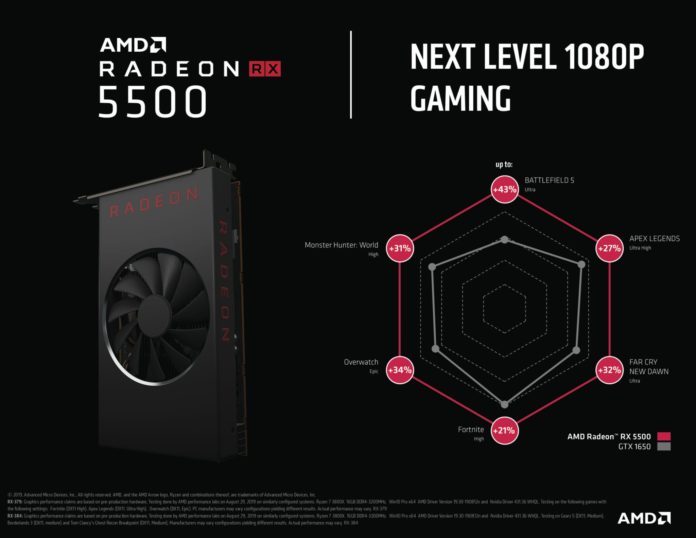It looks like rumours were right once again. AMD’s Radeon RX 5500 XT specs have been leaked along with some early benchmarks. Info regarding a few board partner cards has been shared by prominent Twitter leakers, including the Sapphire, ASRock and Gigabyte vanilla and OC versions. Let’s have a look:

The Sapphire variant has a boost clock of 1900 MHz and the same memory speed as the 5700 series (14 Gbps). There are supposed to be two models: a 4GB and an 8GB. This appears to be the former.

The Sapphire card seems to be the highest clocked card amongst the bunch while all the rest have a boost clock of 1845 MHz and a base clock of 1650-ish. The game clock is 1737 MHz for most cards and most of them seem to be dual-fan variants with lengths over 280mm. The board power is reportedly 135W. Out of the five, three are 8GB while the remaining two are 4GB cards.
| Sapphire RX 5500 XT 4GB | Gigabyte Radeon™ RX 5500 XT OC 8G | Gigabyte Radeon™ RX 5500 XT GAMING OC 4G | ASRock Radeon RX 5500 XT Challenger D 8G OC | ASRock Radeon RX 5500 XT Phatom Gaming D 8G OC | |
| Cores | 1408? | 1408? | 1408? | 1408? | 1408? |
| Base Clock | 1680MHz? | 1733 MHz | 1737 MHz | 1685 MHz | 1610 MHz |
| Game Clock | ? | 1733 MHz | 1737 MHz | 1737 MHz | 1737 MHz |
| Boost Clock | 1900 MHz | 1845 MHz | 1845 MHz | 1845 MHz | 1845 MHz |
| Memory | 4GB GDDR6 | 8GB GDDR6 | 4GB GDDR6 | 8GB GDDR6 | 8GB GDDR6 |
| Board Power | 135W | 135W | 135W | 135W | 135 |
| Dimensions (mm) | ? | 225 x 119 x 40 | 281 x 115 x 40 | 241 x 127 x 42 | 287 x 127 x 53.01 |
I’m making a bit of speculation here in terms of the shader count but it should sit somewhere between the 1650 Super’s 1280 and 1660’s 1408. Navi is much more efficient than Vega, so this is isn’t really a surprise. Plus the process advantage also helps.

- Time Spy: 4800
- Fire Strike: 14300
- Fire Strike Extreme: 6800
Compared to the RX 5500 XT, the GeForce GTX 1650 is more or less par with it in Time Spy but gets an outright beating in Firestrike where the XT manages to perform on par with the likes of the 1660 Super. It’ll be interesting to see where the real-world benchmarks of the RX 5500 XT place it. If the price is right, it’ll be a 1650 S killer for sure. Better performance, more memory, plus RTX is out of the equation.



There should be 64 Stream Processors (cores) per Compute Unit. I’ve assumed that the RX 5500 XT is the full die and so has 24 CU’s. This would give it 1536 cores. The RX 5500 with one pair of CU’s fused off and so 22 active CU’s for 1408 cores. Though nothing is truly equivalent, Nvidia’s higher level unit is called Streaming Multiprocessor’s (SM’s) and the lower level units are called Cuda Cores. The GTX 1650 has 14 SM’s and 896 Cuda. It would come as no suprize that the 5500 demolishes the 1650 in everything but power consumption considering how much bigger the 5500 is. The GTX 1660 has 22 SM’s and 1408 Cuda and the GTX 1660ti has 24 SM’s and 1536 Cuda, these would be closer to equivalent level, but Nvidia has a wider memory bus at 192 bit vs AMD’s 128 bit. It sounds like AMD might launch a RX 5600 with a 192 bit bus to address this deficit.
It looks like the main differentiator’s of AMD’s small cards is going to be the memory subsystem and clocks. The difference between 22 and 24 CU’s doesn’t seem like much. Much lower clocks for much lower power consumption will be bigger I think.
RX 5500 XT vs RX 5300m
22 CU’s @ 1845 MHz vs 1445 MHz, 78%
4 GB vs 3 GB, 75%
128 bit bus vs 96 bit bus, 75%
224 GB/s vs 168 GB/s, 75%
135W vs 50W, 37%
3/4 performance for 3/8 the power.